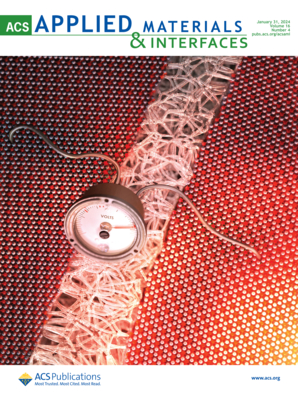原位纳米级快速相位稳定使zr -酚醛气凝胶复合材料在极端热环境中具有优异的抗烧蚀性
IF 8.3
2区 材料科学
Q1 MATERIALS SCIENCE, MULTIDISCIPLINARY
引用次数: 0
摘要
元素杂化酚醛气凝胶复合材料常被用作航天飞行器的轻质热防护材料。zr -酚醛(Zr-PR)气凝胶由于其优异的耐高温性能而得到了广泛的研究。然而,Zr-PR热解产物ZrO2的相变会引起体积变化和内应力,极大地限制了Zr-PR的应用。在这项工作中,将少量的纳米y2o3颗粒直接掺杂到Zr-PR气凝胶复合材料中,形成纳米级马赛克结构。该气凝胶复合材料具有低密度(0.51 g/cm3)和低导热系数(<0.151 W/(m K))的特性;此外,它还显示出抗氧化消融能力的显著改善,线性消融率降低了33%。研究表明,纳米y2o3的掺杂通过在烧蚀表面原位快速形成致密的钇稳定氧化锆(YSZ)热障层,有效地解决了ZrO2相变带来的不利影响,显著延缓了复合材料的热氧化烧蚀。此外,由于YSZ固溶反应产生的催化石墨化效应,烧蚀表面的热解碳(PyC)可以形成丰富的多层石墨烯结构,进一步增强了抗氧化性。本研究为提高Zr-PR气凝胶复合材料的烧蚀性能提供了一种简单有效的方法,拓宽了其在极端热环境中的应用。本文章由计算机程序翻译,如有差异,请以英文原文为准。

In Situ Nanoscale Rapid Phase Stabilization Enables Zr-Phenolic Aerogel Composites with Excellent Ablation Resistance in Extreme Thermal Environments
Element-hybrid phenolic aerogel composites are often utilized as lightweight thermal protection materials for aerospace craft. Zr-phenolic (Zr-PR) aerogels have been extensively studied due to their exceptional high-temperature resistance. However, the phase transformation of ZrO2, the pyrolysis product of Zr-PR, caused the volume changes and internal stresses, greatly limiting the application of Zr-PR. In this work, a small amount of nano-Y2O3 particles was directly doped into the Zr-PR aerogel composites to form the nanoscale mosaic structure. This aerogel composite exhibited properties of low density (0.51 g/cm3) and low thermal conductivity (<0.151 W/(m K)); moreover, it showed a significant improvement in oxidative ablation resistance with a 33% reduction in the linear ablation rate. The research indicated that the doping of nano-Y2O3 effectively addressed the adverse effects associated with ZrO2 phase transformation by in situ rapidly forming (<60s) the dense yttria-stabilized zirconia (YSZ) thermal barrier layer on the ablation surface, which significantly delayed the thermal-oxidative ablation of the composites. Additionally, the pyrolytic carbon (PyC) on the ablation surface can form abundant multilayered graphene structures due to the catalytic graphitization effect produced by the solid-solution reaction of YSZ, which further enhanced the oxidation resistance. This work provides a simple and efficient approach to improve the ablation performance of Zr-PR aerogel composites, broadening their application in extreme thermal environments.
求助全文
通过发布文献求助,成功后即可免费获取论文全文。
去求助
来源期刊

ACS Applied Materials & Interfaces
工程技术-材料科学:综合
CiteScore
16.00
自引率
6.30%
发文量
4978
审稿时长
1.8 months
期刊介绍:
ACS Applied Materials & Interfaces is a leading interdisciplinary journal that brings together chemists, engineers, physicists, and biologists to explore the development and utilization of newly-discovered materials and interfacial processes for specific applications. Our journal has experienced remarkable growth since its establishment in 2009, both in terms of the number of articles published and the impact of the research showcased. We are proud to foster a truly global community, with the majority of published articles originating from outside the United States, reflecting the rapid growth of applied research worldwide.
 求助内容:
求助内容: 应助结果提醒方式:
应助结果提醒方式:


